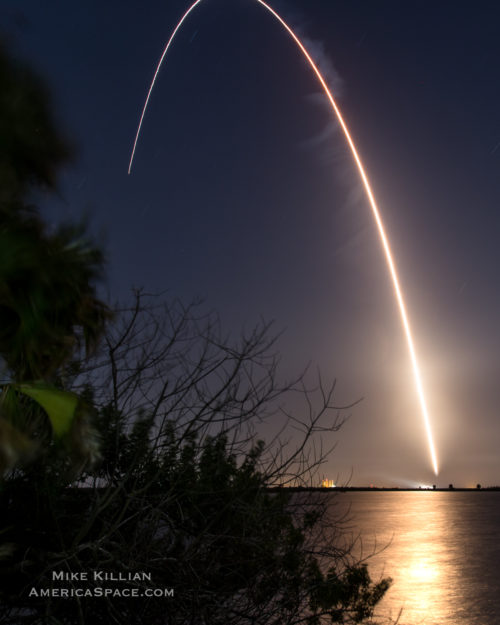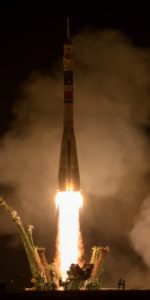
Dedicated to the memory of a former electrical installations lead for the Delta IV Program—30-year aerospace industry veteran Kurt Huschle—the second-to-last “single-stick” United Launch Alliance (ULA) Delta IV booster roared smoothly to orbit this evening (Friday, 15 March), laden with a critical military communications asset to support U.S. and allied warfighters across the globe.
Liftoff of the Delta IV Medium+ (5,4) rocket, equipped with a 16-foot-wide (5-meter) payload fairing and four strap-on, solid-fueled GEM-60 graphite-epoxy motors, took place at 8:26 p.m. ET, after several delays including a first stage helium bottle pressure issue on the rocket, and an issue with NASA’s Tracking and Data Relay Satellite System, which is a mandatory asset for launch.

Forty-two minutes later, as intended, the tenth Wideband Global Satcom (WGS-10) was inserted into supersynchronous transfer orbit, preparatory to a minimum 15 years of operational service. The launch came two days later than planned, as ULA completed “additional troubleshooting to resolve some off-nominal data indications”.
“We are very proud to deliver this critical asset to orbit in support of the U.S. and Allied warfighters deployed around the world defending our national security,” said Gary Wentz, ULA vice president of Government and Commercial Programs. “Thank you to the entire ULA team and mission partners for their outstanding teamwork and dedication to mission success.”
The Boeing-built satellite (and whole WGS fleet) are the Defense Department’s highest capacity communications satellites that provide flexibility to deliver the needed capacity, coverage and connectivity in demanding operational scenarios. It’s the backbone of the DOD, supporting communication networks for all branches of the military.

WGS-10 supports communications links in the X-band and Ka-band spectra, and can instantaneously filter and downlink up to 8.088 GHz of bandwidth. “Depending on the mix of ground terminals, data rates and modulation and coding schemes employed, a single WGS satellite can support data transmission rates over 6 Gbps, and WGS-10 with its advanced digital channelizer may support more than 11 Gbps,” noted the ULA blog.
As outlined in AmericaSpace’s WGS-10 preview article, ULA is phasing-out the expensive single-stick line of its Delta IV fleet of launch vehicles, leaving only the Delta IV Heavy in active service by the end of 2019. “ULA made the decision to retire the Delta IV Medium launch vehicle when our National Security Space customer decided to compete missions in 2015,” explained Tony Taliancich, ULA director and general manager of launch operations, in comments provided to AmericaSpace.
“Prior to the acquisition strategy change, ULA was required by the government to maintain two families of launch vehicles to meet assured access to space policy requirements. In a competitive environment, ULA must favor its lowest-cost product to meet the market requirements. Maintaining multiple product lines would lead to lower launch rates and higher costs.”
With the swansong flight of a Delta IV Medium+ booster—flying in its 5,2 configuration to deliver the second Global Positioning System (GPS) Block III satellite to orbit—currently targeted for July 2019, ULA’s Delta Program with thus hinge only upon the gigantic Delta IV Heavy, which has logged 11 launches to date and most recently lofted the NROL-71 payload for the National Reconnaissance Office in January. This leaves the Atlas V fleet of rockets and the Vulcan-Centaur heavylifter, which is waiting in the wings for its maiden flight, no sooner than April 2021.

“ULA expects that flying-out the Delta IV Medium and transitioning to Vulcan-Centaur will provide the lowest-cost, most reliable support to our launch customers,” said Mr. Taliancich. “ULA will continue flying the Delta IV Heavy launch vehicle as long as it is required by our customers. Once transitioned to Vulcan, we will be able to provide a single-stick Vulcan that can meet Delta IV Heavy mission requirements at a lower price.”
The Common Booster Core (CBC) for today’s flight was delivered to the Cape last July, alongside the Delta Cryogenic Second Stage (DCSS), for horizontal integration at Space Launch Complex (SLC)-37B. In late January, the 170-foot-long (51.8-meter) stack was raised to the vertical on the pad surface and in the first half of February the four GEM-60s were mounted around the CBC’s base. At the end of last month, the WGS-10 satellite—encapsulated within its bulbous payload fairing—was installed atop the vehicle, raising the height of the Delta IV Medium+ (5,4) to 218 feet (66.4 meters). Following the completion of the Launch Readiness Review (LRR) on Thursday, 14 March, the Mobile Service Tower (MST) was retracted in the hours prior to launch.
The weather outlook, according to the 45th Space Wing, was highly favorable, with an 80-percent likelihood of acceptable conditions at T-0, tempered only by a slight risk of infringing the Cumulus Cloud Rule. The skies, however, cooperated wonderfully, while engineers had to troubleshoot some minor issues on the booster and deal with the TDRSS problem.

With those issues dealt with the countdown emerged from its final built-in hold at T-4 minutes and counted down to one minute, whereupon the Range Operations Co-ordinator (ROC) reported that the Eastern Range was “Green”, with no constraints for launch. At T-14 seconds, the Radial Outward Firing Igniters (ROFIs) were activated, sizzling sparkler-like to burn off excess hydrogen, before the liquid oxygen and hydrogen valves of the RS-68A engine opened a few seconds before T-0.
The single Aerojet Rocketdyne-built engine roared to life with a propulsive yield of 705,000 pounds (320,000 kg) and quickly ramped up to full power. At T-0, the four GEM-60 boosters also ignited with their familiar staccato crackle, providing the muscle for the last Delta IV Medium+ (5,4) to punch away from SLC-37B and depart Earth under a combined thrust in excess of 1.8 million pounds (800,000 kg).
Shortly after liftoff, the booster initiated a combined pitch, roll and yaw program maneuver to establish itself onto the correct azimuth to insert WGS-10 into orbit. Bursting through maximum dynamic pressure at 47 seconds into flight, the booster continued upward, ever accelerating, until the four GEM-60s neared the exhaustion of their solid propellants.

At 100 seconds, the first pair of strap-on boosters were jettisoned, followed by the other pair a couple of seconds later. The Delta IV Medium+ (5,4) pressed on, until its RS-68A shut down, as planned, and the CBC separated, some four minutes into flight.
Next, the Aerojet Rocketdyne-built RL-10B-2 engine of the DCSS—which produces 24,750 pounds (11,220 kg) of thrust—began the first of its two major “burns” to deliver WGS-10 to supersynchronous transfer orbit; a “long” burn, lasting over 15 minutes, followed by a “short” burn of just three minutes, which positioned the satellite in an orbit with an apogee of 27,530 miles (44,315 km) and a perigee of 270 miles (434 km), inclined 27 degrees to the equator. Separation of the payload occurred at 36 minutes into flight, after which the RL-10B-2 ignited a third time to dispose the DCSS itself into the Pacific Ocean.
“ULA is proud to be the exclusive launch provider for all ten WGS missions,” said Gary Wentz, ULA vice president of Government and Commercial Programs. “Our focus on mission success continually demonstrates that safely and reliably delivering these critical national assets is our highest priority.”

With two missions thus completed in 2019, ULA is looking forward to an ambitious year, characterized by the first use of a member of the Atlas rocket family to deliver astronauts to space since the Project Mercury days, more than a half-century ago. Next up in the late April/early May timeframe is the inaugural unpiloted test-flight of Boeing’s CST-100 Starliner to the International Space Station (ISS), with a crewed mission later this summer of fall, carrying veteran NASA astronauts Mike Fincke and Nicole Mann, together with Boeing test pilot and former shuttle commander Chris Ferguson.
Other Atlas V missions targeted for 2019 include the latest Advanced Extremely High Frequency (AEHF-5) satellite, the Air Force’s Space Test Payload (STP)-3 and the Orbital Test Vehicle (OTV)-6 mini-shuttle. On the Delta IV side, the final flight of the “single-stick” line in July will be followed by a single Delta IV Heavy mission, laden with the classified NROL-44 payload for the National Reconnaissance Office.

on to deploy WGS-10. Photo: John Studwell / AmericaSpace
All told, the year should conclude with up to nine ULA missions, achieving parity with 2018 and a slight uplift on the eight launches accomplished in 2017. The total yearly number of flights for ULA has dropped from a highpoint of 16 in 2009 to average a dozen or less per annum since 2015.
Yet work at ULA’s factory in Decatur, Ala., where the CBCs, payload fairings and DCSS hardware are fabricated appears to be accelerating. “Our manifest remains flexible in 2019 to accommodate our customer requirements,” said Mr. Taliancich. “2019 is a busy year for us at ULA as we prepare for scheduled launches and a very busy 2020 manifest. In our factory alone, we will be working at a record-setting manufacturing pace, with 30 boosters in production during 2019 and 2020.”
.
.
FOLLOW AmericaSpace on Facebook and Twitter!
.
.





